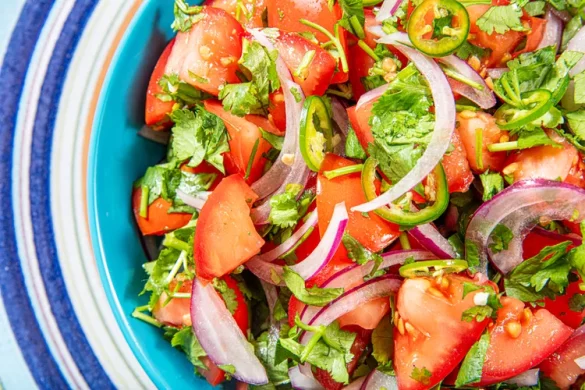Introduction
Kachumbari is a vibrant and refreshing tomato salad that forms an essential part of East African cuisine, particularly in Kenya and Tanzania. Known for its bold flavors and simplicity, Kachumbari is a staple at meals ranging from everyday dinners to special celebrations. This detailed exploration will cover the origins and cultural significance of Kachumbari, the intricacies of its preparation, and variations that showcase its versatility.
The Origins and Cultural Significance of Kachumbari
1. Historical Background
Kachumbari, also known as Kachumbari salad, is deeply rooted in the culinary traditions of East Africa. The dish’s origins can be traced back to the Swahili-speaking coastal regions, where it was traditionally enjoyed as a side dish alongside various staples. Its popularity has spread throughout the region, reflecting the diverse and rich food culture of East Africa.
A. Influence of Local Ingredients
- Tomatoes and Onions: The primary ingredients in Kachumbari—tomatoes and onions—are staples in East African cuisine, widely grown and consumed across the region. These ingredients are used in various dishes, reflecting their importance in local diets.
- Cilantro and Chilies: Cilantro (coriander) and chilies add fresh and spicy elements to the salad, showcasing the local preference for vibrant and bold flavors.
B. Role in East African Cuisine
- Accompaniment to Main Dishes: Kachumbari is often served as a refreshing side dish to complement heavy main dishes such as grilled meats, stews, and pilafs. It provides a contrast to richer dishes with its light and zesty profile.
- Celebratory and Everyday Use: While commonly enjoyed as a side at everyday meals, Kachumbari also makes appearances at festive occasions and celebrations, highlighting its versatility and importance in East African culinary traditions.

Preparation of Kachumbari: Ingredients and Techniques
1. Ingredients
The preparation of Kachumbari involves a selection of fresh and flavorful ingredients. Here’s a comprehensive list of ingredients typically used in Kachumbari, along with their roles in the dish:
A. Fresh Tomatoes
- Selection: Ripe, juicy tomatoes are crucial for the salad. They should be firm but tender, with a rich red color indicating ripeness and flavor.
- Preparation: Tomatoes are usually diced into small, bite-sized pieces. This allows them to blend well with the other ingredients and enhances the overall texture of the salad.
B. Red Onions
- Selection: Red onions are preferred for their mild sweetness and vibrant color. They add a crunchy texture and a slightly sharp flavor that balances the tomatoes.
- Preparation: Red onions are typically thinly sliced and then soaked in cold water for a few minutes to reduce their pungency. This step helps to mellow the onion’s flavor and makes them more palatable.
C. Fresh Cilantro (Coriander)
- Selection: Fresh cilantro adds a burst of herbal freshness to the salad. It should be vibrant green with no signs of wilting or discoloration.
- Preparation: Cilantro is finely chopped and mixed into the salad. Its bright and aromatic qualities complement the tomatoes and onions.
D. Green Chilies
- Selection: For those who enjoy a bit of heat, green chilies are an essential ingredient. They should be fresh and firm, with a bright green color.
- Preparation: Green chilies are finely chopped and added to the salad to provide a spicy kick. The amount can be adjusted based on personal preference.
E. Lemon or Lime Juice
- Selection: Freshly squeezed lemon or lime juice is used to add acidity and brightness to the salad. It helps to balance the flavors and enhance the overall taste.
- Preparation: Juice from the citrus fruit is squeezed directly into the salad, adding a tangy flavor that complements the tomatoes and onions.
F. Salt and Black Pepper
- Selection: Salt and freshly ground black pepper are used to season the salad. These basic seasonings help to enhance the flavors of the other ingredients.
- Preparation: Salt and pepper are added to taste, with a careful balance to ensure the salad is well-seasoned without overpowering the fresh ingredients.
2. Preparation Techniques
The preparation of Kachumbari is straightforward but requires attention to detail to achieve the perfect balance of flavors. Here’s a step-by-step guide to making Kachumbari:
A. Chopping and Mixing
- Dice Tomatoes: Begin by washing and dicing the tomatoes into small, uniform pieces. This ensures that each bite of the salad has a consistent texture and flavor.
- Slice Red Onions: Thinly slice the red onions and soak them in cold water for about 10 minutes. This helps to reduce their sharpness and makes them milder in taste.
- Chop Cilantro: Wash and finely chop the fresh cilantro. Add it to the bowl with the tomatoes and onions.
- Chop Green Chilies: If using, finely chop the green chilies and add them to the bowl. Adjust the quantity based on your preferred level of spiciness.
B. Seasoning and Dressing
- Add Citrus Juice: Squeeze fresh lemon or lime juice over the salad. The acidity from the citrus juice brightens the flavors and adds a tangy element to the dish.
- Season with Salt and Pepper: Add salt and freshly ground black pepper to taste. Mix well to ensure the seasoning is evenly distributed throughout the salad.
- Toss and Serve: Gently toss all the ingredients together to combine. Serve the Kachumbari immediately, or refrigerate it for a short time to allow the flavors to meld.
Variations and Regional Adaptations
1. Traditional Variations
Kachumbari can vary slightly based on regional preferences and individual tastes. Here are a few traditional variations:
A. Avocado Addition
- Creaminess: In some variations, diced avocado is added to the salad. The creamy texture of avocado complements the crispness of the tomatoes and adds richness to the dish.
- Preparation: The avocado should be peeled, pitted, and diced into small pieces before being mixed into the salad.
B. Tomato and Cucumber Mix
- Added Freshness: Some versions of Kachumbari include diced cucumber along with tomatoes and onions. The cucumber adds a refreshing crunch and enhances the salad’s lightness.
- Preparation: Dice the cucumber into small pieces and add it to the salad along with the other ingredients.

2. Modern Adaptations
As Kachumbari gains popularity outside of East Africa, it has been adapted to fit various culinary styles and preferences. Here are a few modern adaptations:
A. Mediterranean Twist
- Feta Cheese: Adding crumbled feta cheese gives the salad a Mediterranean flair. The tangy and creamy feta complements the fresh ingredients and adds depth to the flavor profile.
- Preparation: Crumble the feta cheese over the salad just before serving.
B. Spicy Variations
- Hot Sauce: For those who enjoy extra heat, a splash of hot sauce can be added to the salad. This adds a different kind of spiciness and enhances the overall flavor.
- Preparation: Add a few drops of your favorite hot sauce to the salad and mix well.
C. Herb Variations
- Mint or Basil: Experimenting with different herbs, such as mint or basil, can give Kachumbari a unique twist. These herbs add additional layers of flavor and aroma.
- Preparation: Finely chop the herbs and mix them into the salad along with the cilantro.
Serving Suggestions
1. As a Side Dish
Kachumbari is often served as a side dish alongside a variety of main courses. Its fresh and tangy flavors make it an excellent complement to:
A. Grilled Meats
- Barbecue: Serve Kachumbari with grilled meats such as chicken, beef, or lamb. The salad’s bright flavors contrast beautifully with the smoky richness of grilled dishes.
- Steaks: It also pairs well with steaks, providing a refreshing side that balances the richness of the meat.
B. Stews and Pilafs
- Beef Stew: Kachumbari is a great accompaniment to hearty beef stews. The freshness of the salad cuts through the richness of the stew.
- Rice Pilaf: It can be served with rice pilaf, adding a burst of freshness to the dish.
2. As a Light Meal
Kachumbari can also be enjoyed as a light and healthy meal on its own. Its crisp and refreshing qualities make it an ideal option for:
A. Summer Lunches
- Light and Refreshing: Perfect for hot summer days, Kachumbari offers a light and cooling meal. It’s a great choice for a quick lunch or a picnic.
- Pairing with Bread: Enjoy the salad with a side of crusty bread or pita for a simple and satisfying meal.
B. Appetizer
- Starter Course: Serve Kachumbari as an appetizer at gatherings or parties. Its vibrant colors and flavors make it an appealing and appetizing starter.
Health Benefits and Nutritional Value
1. Nutritional Profile
Kachumbari is not only delicious but also packed with nutritional benefits. Here’s a look at the nutritional profile of its key ingredients:
A. Tomatoes
- Rich in Vitamins: Tomatoes are a great source of vitamins C and A, which support

